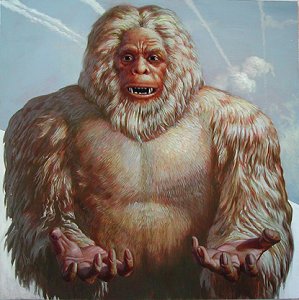
The ancient hindu scriptutres ..Ramayana ,Mahabharata mentioned about this yet mythical creature vividly long back (Hindu Religion is more than 5000 years old ) ..so does the jain texts and so does the folklore (tagged so by western media till date ) of Nepal ,India and Tibet . Itz called by different names .In the forests and plains of Siberia and China these are called Alma ,Sasquatch in South America seems to be the half brother of YETI in Asia and why to forget Yowie in Australia .
YETI is not discovered and we are still clueless but this is my views on it.
YETI might be a gigantic snowman /ape .We can find that evry species we see ,today has or had a giant look alike .Like tigers for cats ,mammoth for elephants , Neanderthals for human, Dinosaurs for Lizards ,so why not YETI for apes ?
Well some proof /counter proof of it now .....
- In 1889, a British army major named L. A. Waddell found large footprints in the snow in northeastern Himalayas.
- In 1925, an expedition led by a Greek photographer N. A. Tombazi noticed a human-like creature about 300 yards away. The creature disappeared before Tombazi could take a picture.
- In 1951, an expedition found a track on the Menlung Glacier between Tibet and Nepal, at an altitude of 6000 meters. The footprints they saw were 33 cm by 45 cm and were made by a foot which has 5 toes of which the inner toes were larger than the others. The heel was flat and exceptionally broad. The track itself appeared to be fresh so the footprints were not enlarged by melting snow. This was clearly shown by the many photographs they took. Although there were many doubts about these photographs, if they were believed to be true at all. But those who did belief were certain that was not made by any known animal.
- British mountaineers Eric Shipton and Michael Ward took some of the best pictures of "the footprints of the Yeti" in 1951. Each footprint were thirteen to eighteen inches long.
- In another expedition by Sir Edmund Hillary, the first ever to climb the Mount Everest. He funded this expedition himself, for he and his guide Tenzing Norgay had seen footprints of a Yeti on a previous expedition. Unfortunately, his expedition was as unsuccessful as those who had gone before. However, he brought back with him a borrowed artifact: the upper half of the skull of a Yeti. This scalp came from the Khumjung Gompa (monastery) in Nepal where it is kept as a relic. It is some 300 years old, 20 cm high and has a circumference of 65 cm. Scientists said it belonged to a serow (mountain goat) which lives in eastern Asia.
